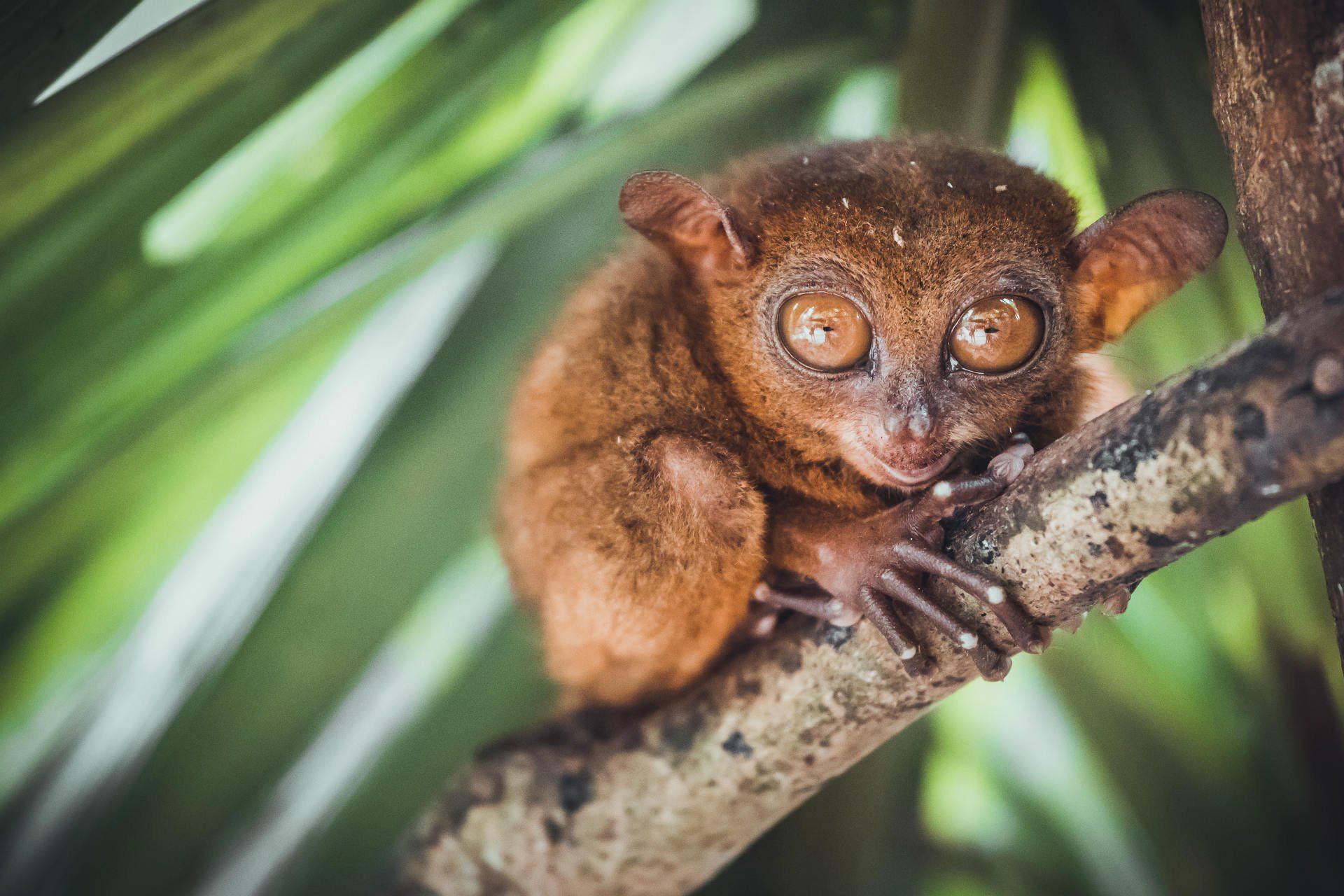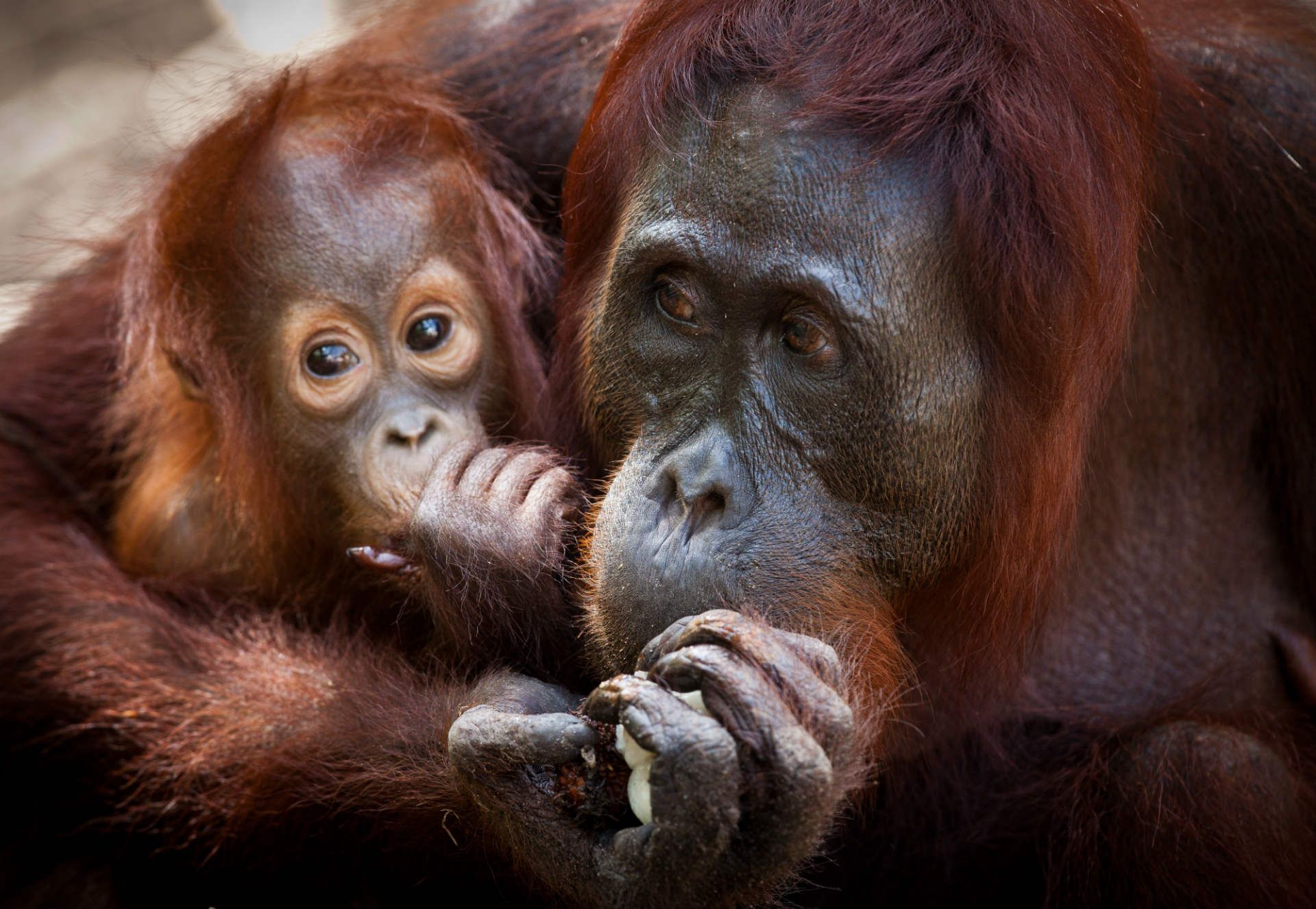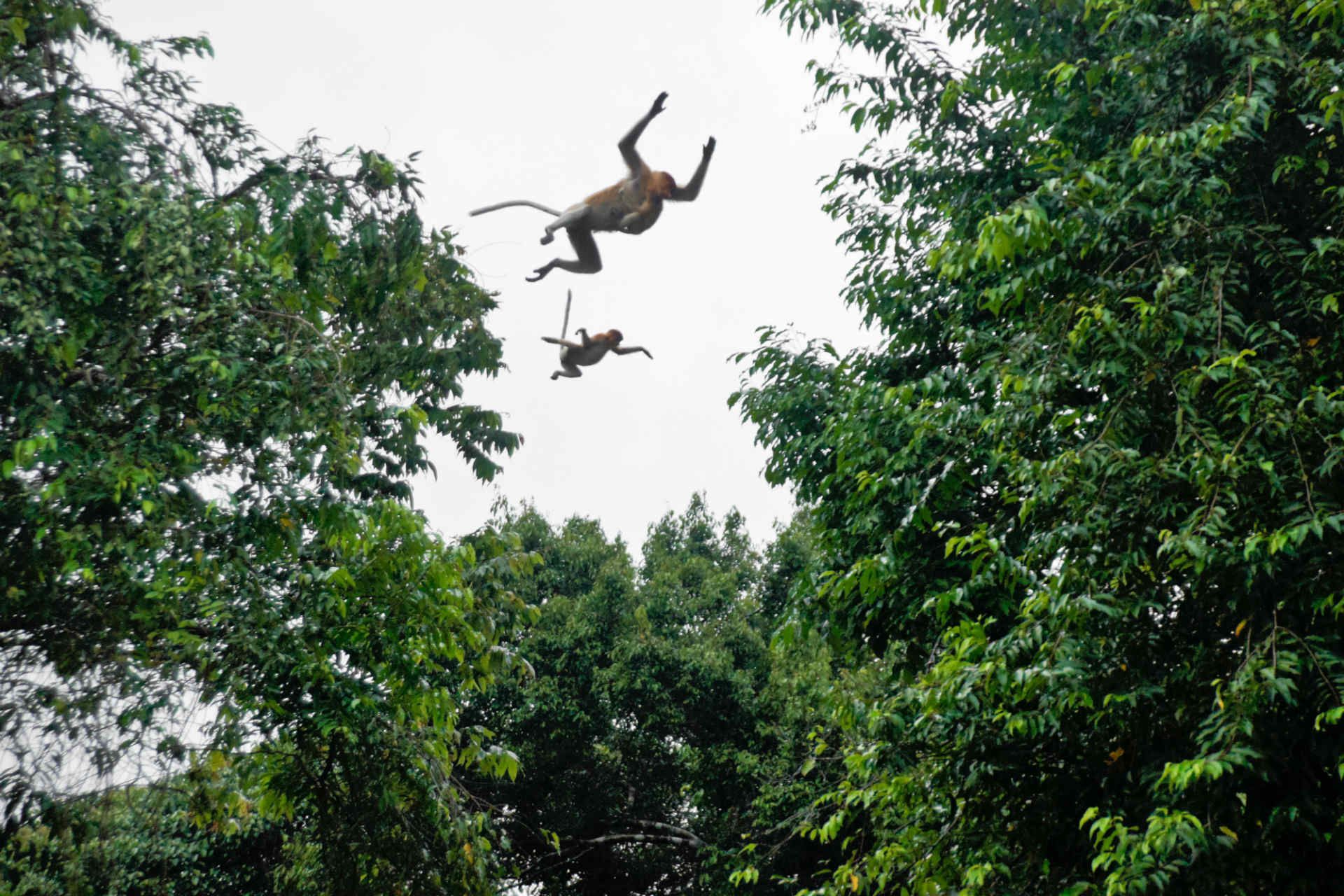- Nature & Wildlife
- National Parks & Reserves
- Wildlife
- Malaysia
- Indonesia
- Inspiration
- See & Do
- Travel Tips
Wild about wildlife? Bump Borneo to the top of your list. Split between Malaysia, Indonesia and tiny Brunei, this island in Southeast Asia’s Malay Archipelago is a biodiversity goldmine — home to carnivorous pitcher plants, pygmy elephants, and, most famously, orangutans.
These endangered apes are only found in two places on Earth: here and on Sumatra. So if seeing orangutans in the wild is on your radar, Borneo is where you want to be. From protected jungle reserves to orangutan rehabilitation centres, there are plenty of ways to spot them — ethically and up close.
Here’s your guide to where and how to see orangutans in Borneo.
- The best places to see orangutans in Borneo
- Best places to see orangutans in Borneo
- 1. Sepilok Orangutan Rehabilitation Centre (Sabah, Malaysia)
- 2. Tanjung Puting National Park (Central Kalimantan, Indonesia)
- 3. Borneo Orangutan Survival Foundation (Central and East Kalimantan, Indonesia)
- Other destinations for orangutan encounters
- Practical tips for seeing orangutans in Borneo
The best places to see orangutans in Borneo
Borneo, the third-largest island in the world, is split between Malaysia (Sabah and Sarawak), Indonesia (Kalimantan), and Brunei. Its ancient rainforests — some over 130 million years old — make it one of the last strongholds for wild orangutans.
These aren’t just any apes. Orangutans are Asia’s only great apes and the largest tree-dwelling mammals on the planet. Their name, orangutan, comes from Malay: “man of the forest.” And once you see one swinging overhead, the name makes perfect sense.
Orangutans in Borneo: What you need to know
Borneo’s orangutans are the island’s celebrity residents. They live mostly alone in the lowland rainforests, spending their days high in the canopy and gorging on wild fruit. You’re unlikely to find them in groups — they’re solitary by nature — but with the right guide and a bit of patience, you’ll spot them in the wild.
Just over a century ago, there were more than 230,000 orangutans across Southeast Asia. Today, fewer than half remain. Borneo is home to an estimated 104,700 orangutans, and although they’re still classified as endangered, conservation efforts are helping to slow the decline.
There are several conservation centers and foundations in Malaysian and Indonesian Borneo working to protect them. Supporting these projects — by visiting responsibly — means you're contributing to their survival.

Orangutans in Borneo © Shutterstock
What other wildlife can you see in Borneo?
While orangutans are the stars of the show, they’re far from the only wildlife worth traveling for. Borneo is a jungle heavyweight: home to 222 species of mammals (44 found nowhere else), 420 bird species (37 endemics), and a dazzling array of reptiles, amphibians, and fish.
Here’s what else you might spot:
- Other primates. Keep an eye out for long-nosed proboscis monkeys (found only in Borneo), cheeky macaques, and swing-happy gibbons.
- Pygmy elephants. These endangered elephants are smaller than their African cousins and stick close to the rivers and rainforests of Sabah.
- Sunda clouded leopards. Elusive and rarely seen, these tree-climbing cats haunt Borneo’s mountain interiors. Experts reckon there are only 5,000–11,000 left.
- Bornean sun bears. The smallest bears in the world, sun bears are hard to spot in the wild — but you can meet rescued ones at dedicated centers near orangutan sanctuaries.
- Birdlife. Borneo is a birder’s paradise. Look for rhinoceros hornbills, crested serpent eagles, stork-billed kingfishers, and brahminy kites.

Orangutan in Borneo ©Shutterstock
Best places to see orangutans in Borneo
When it comes to seeing orangutans in Borneo, not all spots are created equal. Some offer wild jungle treks, others provide close-up encounters with rescued apes learning to survive in the forest. But all of them share one thing: a serious commitment to orangutan conservation.
Whether you're cruising down a remote river in Kalimantan or watching young apes swing through the trees at a rehabilitation center in Sabah, these places offer your best chance at seeing orangutans — ethically, safely, and up close.
1. Sepilok Orangutan Rehabilitation Centre (Sabah, Malaysia)
Sepilok is one of the most accessible and rewarding places to see orangutans in Borneo. Tucked into the rainforest just 22km from Sandakan in the Malaysian state of Sabah, this rural patch of jungle is home to some of Malaysia’s most iconic wildlife — including the rhinoceros hornbill and, of course, orangutans. It’s an easy addition to any Malaysia itinerary that includes wildlife or eco-tourism stops.
A 3km detour off the main road brings you to the Sepilok Orangutan Rehabilitation Centre, one of only a handful of sanctuaries in the world dedicated to rescuing and rehabilitating orangutans. Most of the apes here have been displaced by deforestation or rescued from the illegal pet trade. Some arrive orphaned and traumatized; others never learned how to survive in the wild. Here, they’re given a second chance.
Set in a protected 43-square-kilometer swath of lowland rainforest, the centre helps orangutans relearn essential jungle skills—climbing, foraging, and nest-building—before releasing them back into the forest. Visitors can observe their progress at different stages:
- Nursery viewing gallery: Behind glass, you’ll see juvenile orangutans swinging from ropes and learning to climb.
- Forest trails: Join a guide and explore Sepilok’s tree-lined paths — look up to spot sleeping nests or wild apes passing overhead.
- Feeding platforms: Watch semi-wild orangutans come in for bananas at 10am and 3pm. A no-show often means they're finding food naturally, which is a good sign.
The centre is open daily, 9am–noon and 2–4pm. Get there early to beat the tour groups, and bring binoculars if you can.

Sun bear © Shutterstock
Other attractions near Sepilok
There’s more to Sepilok than just orangutans. The same jungle-fringed road leads to two standout wildlife centers:
Bornean Sun Bear Conservation Centre
Right across from the orangutan centre, this facility rescues and rehabilitates the world’s smallest bear — often targeted for traditional medicine or the exotic pet trade. The Bornean sun bear is adorable, yes, but also vulnerable.
- Around 40 bears live in spacious woodland enclosures.
- Spotting scopes on the boardwalk let you zoom in — ask staff to help line up your camera for killer close-ups.
- Open daily, 9am–3.30pm.
Rainforest Discovery Centre
About 2km further along Sepilok Road, the Rainforest Discovery Centre offers another perspective — literally. Its 347m-long canopy walkway puts you eye-level with the treetops and gives you a real sense of what it’s like to spend a night in the rainforest surrounded by the sounds of nature.
- Open daily, 8am–5pm.
- Bird lovers should bring binoculars: trogons, hornbills, and kingfishers are frequent visitors.
- Don’t miss the guided night walk (Monday–Friday only), where you might spot flying squirrels, slow lorises, and — if you’re lucky — tarsiers.

Get lucky, and you might see a tarsier in the Rainforest Discovery Centre, Borneo © Shutterstock
2. Tanjung Puting National Park (Central Kalimantan, Indonesia)
If you want to see wild orangutans in Borneo while floating down a river in the middle of the jungle, this is the spot. Tanjung Puting National Park, a UNESCO Biosphere Reserve in Central Kalimantan (Indonesian Borneo), is one of the best places in Indonesia to see orangutans in their natural habitat.
Your journey starts in Pangkalanbun, reachable by air from Jakarta, Pontianak, Banjarmasin, and other major Indonesian cities. Once there:
- Get your entry permit at the park office.
- Take a taxi 20 minutes south to Kumai, a riverside village and launch point for the park.
- From the harbor, hire a klotok (a traditional riverboat) or a speedboat to head upriver.
The boat ride is half the experience — drifting through tangled forest, spotting monkeys and hornbills in the trees, and waking up to the jungle chorus.
Orangutan encounters in the park
Tanjung Puting is famous for its orangutan feeding stations, which help supplement food during dry seasons. There are three key outposts:
- Tanjung Harapan: Closest to Kumai, this post houses young orphans and new arrivals. It also has a visitor info center.
- Pondok Tanggui: A quieter option, where semi-wild orangutans (often mothers with babies) swing in for feedings.
- Camp Leakey: The most famous site, and the busiest — especially during high season (June to August). Crowds are common, but it’s also where you’re likely to see dominant males and older orangutans up close.
Feeding sessions are public but serve a conservation purpose: raising awareness while providing a safety net for apes struggling with seasonal food shortages.
What else to do in Tanjung Puting
This park isn’t just about orangutans — it’s a full-blown jungle safari:
- Spot proboscis monkeys, gibbons, macaques, sun bears, clouded leopards, and civets.
- Look out for over 230 bird species, including hornbills and waterbirds, plus crocodiles, snakes, and frogs.
- The river itself is your best wildlife viewing spot. At sunrise, watch proboscis monkeys leap from tree to tree — or belly-flop into the water. Come late afternoon, you’ll see them settling into trees in harem groups for the night.
Travel tip: Ask your klotok captain to cut the engine and let the boat drift — it’s the most peaceful way to take in the jungle, with nothing but bird calls and splashing monkeys around you.

Orangutans in Kalimantan, Borneo © Shutterstock
3. Borneo Orangutan Survival Foundation (Central and East Kalimantan, Indonesia)
If you're serious about supporting orangutan conservation, a visit to the Borneo Orangutan Survival Foundation (BOSF) is a must. BOSF operates two major rehabilitation centers in Kalimantan — Nyaru Menteng in Central Kalimantan and Samboja Lestari in East Kalimantan — both of which fit easily into an Indonesia itinerary focused on wildlife and ethical travel.
Nyaru Menteng Orangutan Rehabilitation Centre
Located 28km north of Palangkaraya, Nyaru Menteng is home to over 300 orphaned and displaced orangutans. This is one of the largest primate rehabilitation facilities in the world, but it isn’t open to casual drop-ins — you’ll need to arrange a permit in advance to visit.
Visitors aren’t allowed to interact directly with the orangutans here, which is a good thing — this site is focused on rewilding apes, not entertaining humans.
Samboja Lestari and Orangutan Sanctuary Islands
If you want to see orangutans in Borneo while actively supporting conservation efforts, Samboja Lodge is the way to go. Managed by BOSF, the lodge offers immersive, low-impact travel experiences:
- Orangutan sanctuary islands: These are man-made forested islands for orangutans who can't be released into the wild. You can observe them from a safe distance as they live semi-wild lives — no cages, no gimmicks.
- Canopy walks and jungle treks: Explore the surrounding forest on guided walks and aerial bridges.
- Boat trips on the Black River: Watch for proboscis monkeys, hornbills, and other wildlife along this remote waterway.
- Sun bear sanctuary: Like BOSF's work with orangutans, their sun bear project rescues and rehabilitates bears exploited by the pet trade or poaching.
The lodge is open weekends (Saturday and Sunday, 9am–5pm) for visitors, but overnight stays are recommended to truly experience the setting. All profits go directly to conservation.
This isn’t just a Borneo orangutan tour — it’s responsible travel at its most meaningful.

As well as orangutans, keep your eyes peeled for proboscis monkeys in Tanjung Puting National Park © Shutterstock

Orangutan © jaiman taip/Shutterstock
Other destinations for orangutan encounters
Looking to stray a little further from the usual orangutan trails? These lesser-visited spots offer a mix of wild sightings, research-backed conservation, and remote jungle adventures. Orangutan encounters aren’t always guaranteed — but that’s part of the thrill.
Danum Valley Conservation Area (Sabah, Malaysia)
A 90-minute 4WD ride from Lahad Datu, the Danum Valley is one of the last remaining patches of untouched lowland rainforest in Southeast Asia. That’s not marketing talk — it’s the verdict of the scientists from the South East Asia Rainforest Research Partnership, who’ve studied the area since the 1980s.
- Wildlife includes bearded pigs, proboscis monkeys, gibbons, elephants, and orangutans.
- Orangutan sightings aren’t guaranteed, but there are guided trails and a canopy walkway that boost your chances.
- This is wild Borneo at its most raw — expect leeches, misty mornings, and no Wi-Fi.
Batang Ai National Park (Sarawak, Malaysia)
Near Lubok Antu, this remote park merges with the Lanjak Entimau Wildlife Sanctuary, creating a large, protected rainforest area home to wild orangutans — an experience that easily ranks among the best things to do in Malaysia.
- You’ll need to hire a licensed guide in Lubok Antu.
- Access is by boat — expect a decent price tag and no on-site facilities.
- Sightings are rare but possible, especially on longer treks.
Matang Wildlife Centre, Kubah National Park (Sarawak, Malaysia)
Just 20km from Kuching, Matang Wildlife Centre is part of Kubah National Park, a rainforest reserve famous for its palm species and network of walking trails.
- The center rehabilitates rescued orangutans, hornbills, gibbons, and other native wildlife.
- While it’s not a place for wild sightings, it plays a key role in conservation — and gives you a chance to learn how the rehabilitation process works.
Bohorok Orangutan Centre, Gunung Leuser National Park (Sumatra, Indonesia)
For a bonus destination outside of Borneo, head to Bukit Lawang in Gunung Leuser National Park, Sumatra. The Bohorok Orangutan Centre no longer rehabilitates apes, but it’s still one of the top places to see orangutans in the wild.
- Accessed via a winding road northwest from Medan (3 hours by car).
- Join a one-hour jungle hike to reach feeding platforms used by wild and semi-wild orangutans.
- Early morning and late afternoon are the best times for sightings.

Orangutans doing their thing in Borneo © Shutterstock
Practical tips for seeing orangutans in Borneo
Before you grab your boots and binoculars, here are a few things to know to make your orangutan adventure smooth, safe, and worth every sweaty step.
- Book ahead. Whether you’re after a guided Borneo orangutan tour or planning to stay at a conservation lodge, it’s smart to book well in advance — especially in peak season (June to August).
- Traveling independently? Some parks and reserves require permits to enter, so double-check requirements before you go, especially in places like Tanjung Puting and Nyaru Menteng.
- Best time to visit Borneo to see orangutans? March to October is your sweet spot. April and May are ideal, with drier weather and the start of fruiting season — orangutans are more active and easier to spot.
- Prepare for the heat. It’s hot, humid, and sweaty year-round in Borneo’s lowland rainforests. Drink loads of water and take regular breaks.
- Dress for the jungle. Long sleeves and trousers help protect against insects and sunburn. Leeches are a thing — especially in the wet undergrowth — so tuck your trousers into your socks and consider leech socks if you’re trekking.
- Bring insect repellent. You’ll need it. And not the polite kind — go for something strong, preferably DEET-based.

Borneo © Shutterstock
Inspired to see orangutans in Borneo for yourself? Get yourself The Rough Guide to Malaysia, Singapore and Brunei to help plan your trip.
